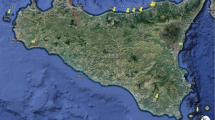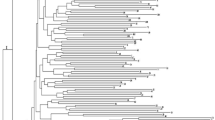Abstract
Damask roses are grown in several European and Asiatic countries for rose oil production. Twenty-six oil-bearing Rosa damascena Mill. accessions and 13 garden Damask roses were assayed by molecular markers. Microsatellite genotyping demonstrated that R. damascena Mill. accessions from Bulgaria, Iran, and India and old European Damask rose varieties possess identical microsatellite profiles, suggesting a common origin. At the same time, the data indicated that modern industrial oil rose cultivation is based on a very narrow genepool and that oil rose collections contain many genetically identical accessions. The study of long-term vegetative propagation of the Damask roses also reveals high somatic stability for the microsatellite loci analyzed.

Similar content being viewed by others
References
Arens P, Coops H, Jansen J, Vosman B (1998) Molecular genetic analysis of black poplar (Populus nigra L.) along Dutch rivers. Mol Ecol 7:11–18
Ağaoğlu Y, Ergul A, Baydar N (2000) Molecular analyses of genetic diversity of oil rose (Rosa damascena Mill.) grown in Isparta (Turkey) region. Biotechnol Biotechnol Eq 14:16–18
Ballard R, Rajapakse S, Abbott A, Byrne D (1995) DNA markers in rose and their use for cultivar identification and genome mapping. Acta Hortic 424:265–268
Baydar N, Baydar H, Debener T (2004) Analysis of genetic relationships among Rosa damascena plants grown in Turkey by using AFLP and microsatellite markers. J Biotechnol 111(3):263–267
Beales P, Cairns T, Duncan W, Fagan G, Grant W, Grapes K, Harkness P, Hughes K, Mattock J, Ruston D, Sutherland P, Williams T (1998) Botanica’s roses. The encyclopedia of roses. Random House, Australia
Ben-Meir H, Vainstein A (1994) Assessment of genetic relatedness in roses by DNA fingerprint analysis. Sci Hortic 58:115–121
Cloutier D, Rioux D, Beaulieu J, Schoen DJ (2003) Somatic stability of microsatellite loci in Eastern white pine, Pinus strobus L. Heredity 90:247–252
Crespel L, Gudin S, Meynet J, Zhang D (2002) AFLP-based estimation of 2n gametophytic heterozygosity in two parthenogenetically derived dihaploids of Rosa hybrida L. Theor Appl Genet 104:451–456
Debener T, Mattiesch L (1999) Construction of a genetic linkage map for roses using RAPD and AFLP markers. Theor Appl Genet 99:891–899
Debener T, Bartels C, Mattiesch L (1996) RAPD analysis of genetic variation between a group of rose cultivars and selected wild rose species. Mol Breed 119:71–74
Debener T, Janakiram T, Mattiesch L (2000) Sports and seedlings of rose varieties analysed with molecular markers. Plant Breeding 119:71–74
Esselink GD, Smulders MJM, Vosman B (2003) Identification of cut rose (Rosa hybrida) and rootstock varieties using robust sequence tagged microsatellite site markers. Theor Appl Genet 106:277–286
Esselink D, Nybom H, Vosman B (2004) Assignment of allelic configuration in polyploids using the MAC-PR (Microsatellite DNA Allele Counting–Peak Ratios) Method. Theor Appl Genet 109:402–408
Hokanson SC, Szewc-McFadden AK, Lamboy WF, McFerson JR (1998) Microsatellite (SSR) markers reveal genetic identities, genetic diversity and relationships in a Malus × domestica Borkh. core subset collection. Theor Appl Genet 97:671–683
Hurst CC (1941) Notes on the origin and evolution of our garden roses. J Roy Hortic Soc 66:242–250
Hvarleva T, Rusanov K, Lefort F, Tsvetkov I, Atanassov A, Atanassov I (2004) Genotyping of Bulgarian Vitis vinifera L. cultivars by microsatellite analysis. Vitis 1:27–34
Iwata H, Kato T, Ohno S (2000) Triparental origin of Damask roses. Gene 259:53–59
Jan CH, Byrne DH, Manhart J, Wilson H (1999) Rose germplasm analysis with RAPD markers. HortScience 34(2):341–345
Krussmann G (1962) Handbuch der Laubgeholze. Berlin-Hamburg
Lefort F, Douglas C (1999) An efficient micro-method of DNA isolation from mature leaves of four hardwood tree species Acer, Fraxinus, Prunus and Quercus. Ann For Sci 56(3):259–263
Lian C, Oishi R, Miyashita N, Hogetsu T (2004) High somatic instability of a microsatellite locus in a clonal tree, Robinia pseudoacacia. Theor Appl Genet 108:836–841
Martin M, Piola F, Chessel Jay M, Heizmann P (2001) The domestication process of the modern rose: genetic structure and allelic composition of the rose complex. Theor Appl Genet 102:398–404
Millan T, Osuna F, Cobos S, Torres M, Cubero J (1996) Using RAPDs to study phylogenetic relationships in Rosa. Theor Appl Genet 92:273–277
Nybom H, Esselink G, Werlemark G, Vosman B (2004) Microsatellite DNA marker inheritance indicates preferential pairing between two highly homologous genomes in polyploid and hemisexual dog-roses, Rosa L. sect. Caninae DC. Heredity 92:139–150
Rahman M, Rajora O (2001) Microsatellite DNA somaclonal variation in micropropagated trembling aspen (Populus tremuloides). Plant Cell Rep 20:531–536
Rajapakse S, Hubbard M, Kelly J, Abbott A, Ballard R (1992) Identification of rose cultivars by restriction fragment length polymorphism. Sci Hort 52:237–245
Rajapakse S, Byrne DH, Zhang L, Anderson N, Arumuganathan K, Ballard R (2001) Two genetic linkage maps of tetraploid roses. Theor Appl Genet 103:575–583
Riaz S, Garrison K, Dangl G, Boursiquot J-M, Meredith C (2002) Genetic divergence and chimerism within ancient asexually propagated winegrape cultivars. J Am Soc Hort Sci 127:508–514
Saakov SG, Rieksta DA (1973) Roses. Zinatne, Riga (in Russian)
Staikov V, Kalaijiev I (1980) Study of oil roses (Rosa damascena Mill.) originated from India, Morocco, Iran and Bulgaria (in Bulgarian). Plant Sci XVII(4):58–68
Storme V Vanden, Broeck A, Ivens B, Halfmaerten D, Van Slycken J, Castiglione S, Grassi F, Fossati T, Cottrell JE, Tabbener HE, Lefèvre F, Saintagne C, Fluch S, Krystufek V, Burg K, Bordács S, Gebhardt K, Vornam B, Pohl A, Alba N, Agúndez D, Bovenschen J, van Dam BC, van der Schoot J, Vosman B, Boerjan W, Smulders MJM (2004) Ex situ conservation of Black poplar in Europe: genetic diversity in nine gene bank collections and their value for nature development. Theor Appl Genet 108:969–981
Thioulouse J, Chessel D, Dolédec S, Olivier JM (1997) ADE-4: a multivariate analysis and graphical display software. Stat Comput 7(1):75–83
Topalov V (1978) The Kazanlak rose and the rose production in Bulgaria (in Bulgarian). Christo Danov, Plovdiv
Vosman B, Visser D, Rouppe J, van der Voort, Smulders MJM, van Eeuwijk F (2004) Detection of mutants and the establishment of essential derivation among rose varieties using AFLP. Theor Appl Genet 109:1718–1725
Zhang L, Ballard R, Rajapakse S (2002) Generation of SSR markers for rose genetic mapping and cultivar fingerprinting. Plant, Animal and Microbe Genomes X Conference, 12–16 January 2002, San Diego
Acknowledgements
The authors are grateful to Dr. P. Heizmann, Lyon University; Mr. Franchelin, Roseraie du Val de Marne, France; Dr. F. Leffort, PSL, Switzerland; and David Austin, Roses, UK, for supplying us with leaves of Damask roses. The valuable discussions and critical reading of the manuscript by Dr. P. Heizmann and Dr. F. Leffort are highly appreciated. This work was financially supported by the National Science Fund, Ministry of Education and Science, project no. G5-091104.
Author information
Authors and Affiliations
Corresponding author
Additional information
Communicated by C. Möllers
Rights and permissions
About this article
Cite this article
Rusanov, K., Kovacheva, N., Vosman, B. et al. Microsatellite analysis of Rosa damascena Mill. accessions reveals genetic similarity between genotypes used for rose oil production and old Damask rose varieties. Theor Appl Genet 111, 804–809 (2005). https://doi.org/10.1007/s00122-005-2066-9
Received:
Accepted:
Published:
Issue Date:
DOI: https://doi.org/10.1007/s00122-005-2066-9




